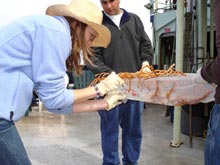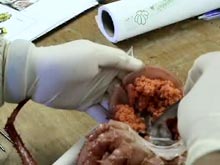
Naomi Ward collects mucus from a large bamboo coral specimen as Kevin Penn looks on. Click image for larger view.
Bamboo coral specimen with mucus clearly visible. Click image for larger view.
Corals and Their Bacteria: A Genetic Exploration
August 10, 2004
Naomi Ward
Assistant Investigator
The Institute for Genomic Research Rockville, MD
Bacteria make the world go round. There is more microbial biomass (living stuff) on Earth than the biomass of all other life forms put together. The bacteria that give you plague, cholera, and all those other nasty diseases are in fact a tiny minority of the bacterial world. The rest of them are busy keeping us alive: generating our atmosphere; recycling carbon, nitrogen, and sulfur; and breaking down dead stuff.
The more we learn about bacteria, the more we know about our world. In last 10 or so years, however, we have found that our tried-and-trusted methods for studying these beasties (growing them on agar plates and in tubes full of yeasty broths) has been a spectacular failure. New methods, which by-pass the cultivation step and identify "bugs" based on their DNA sequences, have revealed that cultivation gives us 0.1-1% of all the bacteria that are out there. (The rest of them are picky eaters, not particularly keen on the agar we feed them in the lab.) That's why, on this Gulf of Alaska mission, we will use the DNA-sequencing approach to study the bacterial communities associated with deep-sea corals.
Because of their relative inaccessibility, deep-sea corals have not been as well-studied as their shallow-water cousins. There is much to be learned about their distribution, reproduction, and relationships with other creatures in the deep-sea environment. Some of these relationships, we think, hinge on the thick mucus produced by the corals. This mucus is thought to have a mostly protective function, guarding the coral against threats, such as drying out (more a problem in tidal shallow-water habitats) and colonization by other creatures.
The mucus also provides an ideal home for teeming bacteria, which have been found at a density of thousands per drop of mucus in shallow-water corals. Coral mucus is released from the coral, drifts through the water column picking up other particles, and eventually falls down to the sediment, where it is snapped up by detritus feeders. So the mucus and its associated microbes are an important part of the food web.

![]() A scarlet king crab, from the genus Lithodes, which means "rock-shaped," is dissected in the lab. (mp4, 7.2 MB)
A scarlet king crab, from the genus Lithodes, which means "rock-shaped," is dissected in the lab. (mp4, 7.2 MB)
From our 2002 Gulf of Alaska expedition, we know that the mucus on deep-sea corals contains microbes, and there is some evidence that different coral species harbor specific microbial populations. We hope to gain many more samples on this mission. The samples will help us to answer questions about this system, such as: Do different coral species really attract different microbes? If so, why? And how? Do the animals we see perched on the corals feed on the mucus and microbes? Why does one coral host lots of animals, while a neighboring seemingly-identical coral is bare? Could it have something to do with the mucus and its microbes?
So, here we are on the R/V Atlantis, armed with collection tubes, microscopes, and DNA extraction kits to try to get some answers.
Sign up for the Ocean Explorer E-mail Update List.


























